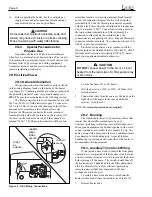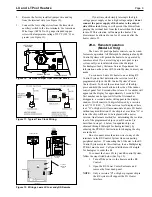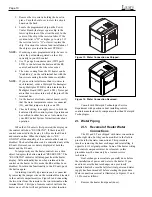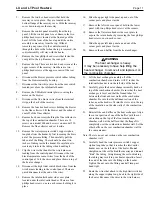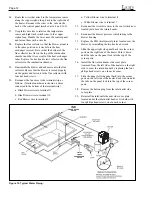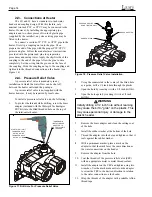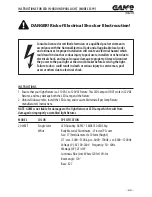
Page 22
then the ignitor will glow and the gas valve will energize.
The water temperature and flue temperature will increase
as gas combustion takes place.
The heater will attempt to ignite three times in
succession. If, after three attempts for ignition, the heater
does not sense the presence of flame, the heater goes into a
lockout mode and must be reset to fire. This can be done
on both model heaters by pressing and releasing the mode
button so that the heater is turned off and then returned to
the desired mode.
If the heater cannot fire, a diagnostic message is
displayed on the left side of the
Model LX
LCD screen on
the control panel, or by a lighted indicator on the
Model
LT
control panel. Review the potential causes listed on the
opposite page for the code on the display. The unit may
require service from a qualified professional serviceman.
Contact Waterpik Technologies for your nearest qualified
service organization. Be sure to note the serial number and
model number before calling. The address of Waterpik
Technologies is displayed on the rear cover of this manual.
IMPORTANT
: The temperature controls cannot be
calibrated in the field. If the temperature control does not
work, shut down the heater and replace the temperature
control. DO NOT rely on temperature control to shut the
heater off. Remove the heater door and turn the main gas
valve to OFF.
3C. Lighting and Shutdown
3C-1. Lighting the Heater
Do not attempt to light the heater with the door
off. Doing so may cause severe bodily injury.
Lighting and shutdown instructions are listed on the
label attached to the inside of the heater door and on the
following page. Lighting instructions are as follows:
1.
Turn off all electrical power to the heater at the main
junction box.
2.
Remove the heater door and turn the heater gas valve
to off.
3.
Wait 5 minutes before trying to start the heater.
4.
Turn the gas valve control knob counterclockwise to
ON (see Figure 22.)
5.
Replace the heater door.
6.
Turn on electrical power to the heater.
7.
Turn on the filter pump.
8.
Set the heater controls to the "SPA" position (mode).
If the temperature of the water exceeds the thermostat
setting it is necessary to increase the thermostat
setting to exceed the water temperature. Adjust the
thermostat setting to be greater than the water
temperature (desired temperature). The ignitor lights
the burner when the thermostat calls for heat.
9.
Set the time clock, if one is installed.
3C-2. Shutdown
Complete shutdown instructions are as follows:
1.
Set both temperature controls to their lowest setting.
2.
Press and release the mode button until the indicators
show that the heater is off.
3.
Turn off all electrical power to the heater at the
junction box.
4.
Open the heater door and turn the gas valve knob
clockwise to off.
5.
Shut off the external gas supply valve to the heater.
3D. Water Chemistry
All auto-chemical feeders must be installed
'downstream' of the heater. A check valve
must be installed between the heater and the
chemical feeder to prevent chemical corrosion
of the heater's heat exchanger.
Do not put any chemicals into the filter skimmer
or intake. Concentrated chemicals can damage
the heat exchanger and will void the
manufacturer's warranty.
3D-1. Pools
The mineral content of swimming pool water
increases daily, due to natural evaporation and the
addition of sanitizing chemicals. If the mineral
concentration in the pool gets too high, the excess
minerals will deposit on the walls of the pool, in the filter
system, and in the heater tubes. It is important to keep the
pH factor of the pool water between 7.2 and 7.6. See Table
6 for guidelines on other chemical measurements.
3D-2. Spas
The proper chemical balance in spa water is more
critical than in a swimming pool heater operation. Due to
the spa's size, high water temperature, and heavy usage,
chemical values in a spa can vary greatly. This chemical
imbalance can result in unsanitary water conditions, and
affect the life of the heater.
WARNING
Caution

